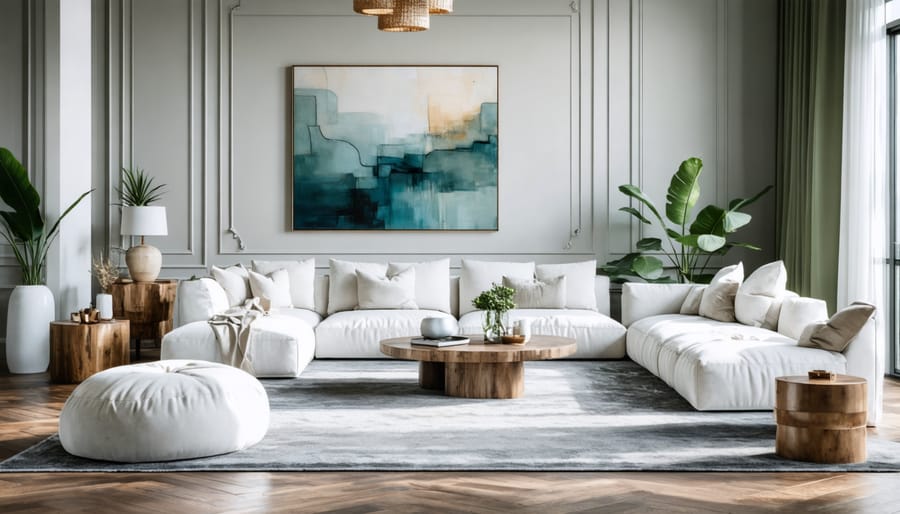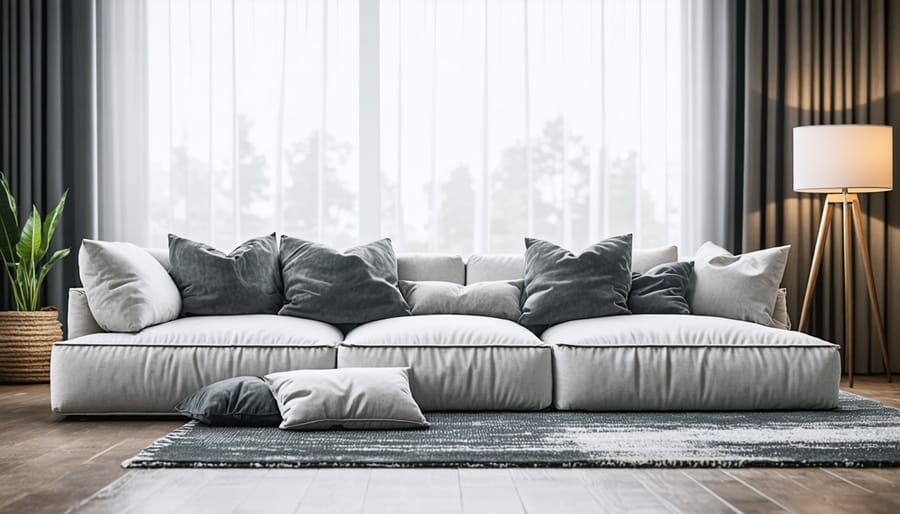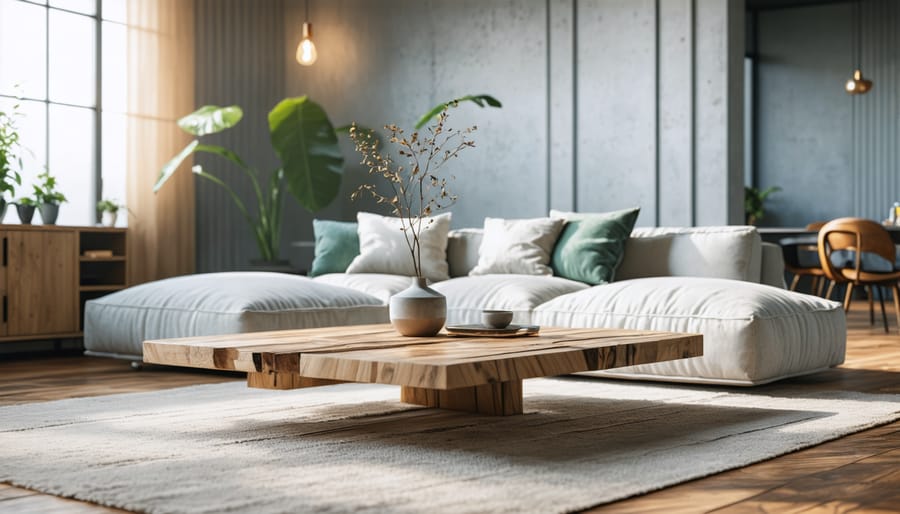Position your area rug so all furniture legs rest on it, or at minimum, place the front legs on while back legs sit off—this creates visual cohesion and anchors your seating arrangement. Maintain 12-18 inches of exposed flooring between the rug edge and walls to frame the space properly and prevent that cramped, wall-to-wall carpet look. Center your rug under the coffee table with equal spacing on all sides, ensuring anyone seated can comfortably place their feet on the soft surface without stretching.
The difference between a living room that feels professionally designed and one that looks haphazard often comes down to this single element. When you nail rug placement, everything else falls into place—your furniture suddenly looks intentional, traffic flow improves, and the room develops that magazine-worthy polish you’ve been chasing. Getting it wrong, however, creates awkward gaps, makes furniture appear disconnected, and can actually make your room feel smaller.
Understanding these interior design fundamentals transforms your space from confused to curated. Whether you’re working with a cozy apartment or an expansive great room, the right rug placement strategy makes all the difference in creating a living room that’s both beautiful and livable.
The Foundation Rule: Why Your Rug Size Matters First
Measuring Your Space Before You Shop
Before you fall in love with that gorgeous rug online, grab your measuring tape—this simple step will save you from the disappointment of a too-small (or too-large) rug that throws off your entire living room design. Understanding room design basics starts with accurate measurements, so let’s make this easy and foolproof.
Start by measuring your living room’s length and width, noting where doorways, windows, and fixed features sit. Next, measure your furniture arrangement—the sofa, coffee table, chairs, and side tables. Write down the distances between pieces, paying special attention to walkways. You’ll need at least 18-24 inches of clearance for comfortable traffic flow around the rug.
Here’s a game-changing trick: use painter’s tape to mark out potential rug dimensions directly on your floor. This lets you “try before you buy” and actually walk around the space, sit on your furniture, and see how the size feels in real life. You’ll quickly notice if that 8×10 you had in mind actually looks smaller than expected, or if you can confidently size up.
Take photos from different angles with the tape outline visible—they’ll be invaluable when you’re shopping online or in-store. This visual reference helps you stay grounded when faced with showroom rugs that can look deceptively different on a vast retail floor versus your cozy living room.
The Three Classic Placement Strategies (And When to Use Each)
All Furniture On: The Anchored Look
This is the gold standard of living room rug placement—the approach that interior designers often call “the anchored look.” When all furniture legs sit completely on the rug, you create a cohesive, intentional space that feels pulled together and sophisticated. Think of your rug as an island that holds everything in one unified zone.
Visually, this arrangement creates clear boundaries in your living room. The rug becomes a defined conversation area, with your sofa, chairs, coffee table, and side tables all resting firmly on its surface. Nothing’s left floating awkwardly on bare floor, and the entire seating arrangement feels like it belongs together as one thoughtful unit.
**The Pros:** This placement style makes rooms feel larger and more luxurious because it eliminates that choppy, disconnected feeling you get when furniture straddles the edge of a rug. It’s particularly stunning in open-concept spaces where you need to visually separate the living area from the dining or kitchen zones. Plus, it’s incredibly comfortable—no one’s chair legs tip backward off the rug edge when they lean back to relax.
**The Cons:** You’ll need a generously sized rug, which means a bigger investment. For a standard living room with a three-seat sofa and two accent chairs, you’re looking at a minimum 9’x12′ rug, though many spaces benefit from 10’x14′ or even larger. Smaller rooms might feel overwhelmed by this approach, making the space appear cramped rather than cohesive.
**Making It Work:** Aim for at least 18-24 inches of rug extending beyond your furniture on all sides. This breathing room prevents that “packed sardine” effect and maintains visual balance.

Front Legs Only: The Most Versatile Approach
If you’re looking for a placement strategy that works beautifully in most living rooms without breaking the bank or requiring massive rug investments, the front-legs-on approach is your best friend. This method strikes that perfect balance between creating a cohesive, pulled-together look and offering flexibility for various room sizes and furniture arrangements.
Here’s how it works: position your rug so that just the front legs of your major furniture pieces rest on it, while the back legs remain on the floor. For your sofa, this means the front two legs sit comfortably on the rug’s edge, typically 6-12 inches from the border. The same principle applies to accent chairs flanking the seating area—front legs on, back legs off.
This technique creates an invisible frame that visually anchors your furniture grouping without requiring an enormous rug. It’s particularly brilliant for those in-between spaces where a small rug feels too disconnected but a room-sized rug exceeds your budget or available square footage.
Your coffee table should sit entirely on the rug, centered within the arrangement. This creates a natural focal point and ensures the area where people actually interact—setting down drinks, putting up feet, gathering around—feels intentionally designed rather than haphazard.
The beauty of this approach lies in its forgiving nature. Have mismatched furniture depths? No problem. Need to accommodate a recliner that extends backward? You’re covered. Planning to rearrange occasionally? The front-legs-on method adapts beautifully without looking awkward.
For best results, aim for at least 18-24 inches of rug extending beyond your coffee table on all sides. This creates breathing room and prevents that “floating island” effect that makes spaces feel disconnected and visually choppy.

Furniture Floating: When Less is More
Think of the floating furniture approach as giving your rug a bit of breathing room—literally. Instead of anchoring all your furniture on the rug, you’re creating a design island in the center of your space. This technique works beautifully when your rug sits independently under just your coffee table, with your sofa and chairs pulled back so their front legs rest on bare floor.
It’s a game-changer for small living rooms where every inch counts. By keeping larger furniture pieces off the rug, you’re visually expanding your floor space while still defining your conversation area. Your eye doesn’t get stopped by furniture edges, creating that coveted open, airy feeling.
This approach also shines when you’re working with a statement rug you really want to showcase. Maybe you’ve scored a gorgeous vintage find or invested in a bold geometric pattern—floating it allows the design to take center stage without being obscured by furniture.
For the best results, choose a rug that’s large enough to ground your coffee table with at least 12-18 inches extending beyond it on all sides. This creates proper visual balance without looking like a tiny postage stamp in the middle of your room.
The floating method also plays well with layered design looks. You can place a smaller, eye-catching rug over a larger neutral base, creating depth and personality. It’s perfect for those who love switching up their style seasonally without committing to a full room makeover.

Getting the Spacing Right: The Numbers That Actually Matter
The 18-Inch Rule and When to Break It
The golden rule of area rug placement is maintaining an 18-24 inch border between your rug’s edge and the walls. This guideline creates a balanced frame around your rug, preventing that awkward “floating island” look while giving your room visual breathing space. Think of it as matting for artwork—that border draws the eye inward and makes everything feel intentional.
But here’s where it gets fun: rules are made to be broken! In smaller living rooms (under 150 square feet), strict adherence to the 18-inch rule might leave you with a postage stamp-sized rug that doesn’t anchor your furniture properly. If you’re working with limited space, don’t hesitate to reduce that border to 12 inches or even 8 inches on some sides. The key is consistency—if you go narrower on one wall, mirror that measurement on the opposite side to maintain visual balance.
For studio apartments or cozy spaces, you might even position your rug closer to one wall while maintaining wider borders elsewhere, creating an asymmetrical layout that actually enhances the room’s proportions and makes your seating area feel more defined rather than cramped.
Coffee Table Placement: Finding the Sweet Spot
Your coffee table and rug relationship is crucial for both aesthetics and functionality. The golden rule? Center your coffee table on the rug whenever possible. This creates visual harmony and ensures your space feels intentional rather than haphazard.
Here’s where measurements really matter: maintain 14 to 18 inches between your coffee table edge and the front of your seating. This sweet spot gives you comfortable legroom while keeping drinks and snacks within easy reach. Too close, and you’ll feel cramped; too far, and you’ll be doing awkward stretches for your coffee mug.
Think of your coffee table as the anchor point. It should sit completely on the rug with at least 8 to 10 inches of rug visible on all sides. This framing effect draws the eye and defines your conversation area beautifully. If your coffee table legs are peeking off the rug edge, it’s time to size up—trust me, it’ll look more polished and professional with everything properly grounded.
Solving Common Living Room Layout Challenges
Small Living Rooms: Making Space Feel Bigger
In a small living room, your instinct might be to downsize everything—including your rug. But here’s where things get counterintuitive: a larger rug actually makes your space feel more expansive, not cramped. Think of your rug as the visual foundation that unifies the room. When you choose a too-small rug, it fragments the space into disconnected zones, making everything feel choppy and, ironically, smaller.
Aim for a rug that fits at least the front legs of all your seating pieces, even in tight quarters. An 8×10 rug often works better than the 5×7 you’re eyeing—it creates one cohesive visual plane that tricks the eye into perceiving more square footage. If budget is a concern, consider that one properly-sized rug delivers more impact than multiple small accent rugs scattered around.
Avoid the “floating island” effect where a tiny rug sits marooned in the center with furniture pushed against the walls. Instead, let your rug anchor the conversation area, pulling pieces together. If you can’t fit all furniture on the rug, that’s perfectly fine—consistency matters more than coverage. The result? Your compact living room will feel intentionally designed rather than accidentally small.
Open-Concept Spaces: Defining Your Living Zone
Open-concept living presents a wonderful opportunity to get creative with rugs! When your kitchen flows into your dining area and right into your living space, area rugs become your secret weapon for defining distinct zones without building walls.
Think of your rug as an invisible room divider. Position it to anchor your seating area, keeping all front furniture legs on the rug while maintaining at least 12-18 inches of exposed flooring around the perimeter. This creates breathing room and signals “this is the conversation zone” without disrupting the open flow you love.
Here’s a practical tip: align your rug parallel to the main architectural lines of your space—whether that’s your fireplace, windows, or the longest wall. This cohesive design approach helps different areas feel intentionally connected rather than randomly scattered.
For visual continuity between zones, consider using rugs in complementary styles or colors. Your living room might feature a plush neutral rug while your dining area showcases a flatweave with similar tones. Different textures, unified palette—it’s that simple!
The goal isn’t isolation; it’s definition. Your rugs should guide the eye naturally from one space to another, creating purposeful areas that still feel like one harmonious home.
Awkward Room Shapes and Multiple Seating Areas
Not every living room is a perfect rectangle with one clear focal point, and that’s where things get interesting! If you’re working with an L-shaped room, consider using two coordinating rugs to define each seating zone—this creates visual separation while maintaining flow. Choose rugs with complementary colors or patterns that feel like they belong to the same family.
For rooms with a fireplace *and* a TV on different walls (we’ve all been there!), you can actually angle your furniture toward the space between them and let your rug anchor this compromise arrangement. The rug becomes the unifying element that says “this is one cohesive conversation area,” even when your focal points compete for attention.
Got multiple conversation spots? Layer smaller rugs within a larger neutral base, or use distinct rugs for each zone—just make sure they share at least one design element, whether that’s color, texture, or style. Think of it like creating rooms within a room. In open-concept spaces, rugs are your secret weapon for carving out purposeful areas without building walls. The key is ensuring each rug fully supports its furniture group, following those same “all legs on” or “front legs on” principles we’ve discussed.
The Visual Impact: How Placement Changes Your Room’s Feel
Your rug isn’t just a decorative accessory—it’s a powerful design tool that can completely transform how your living room feels and functions. The placement you choose creates an invisible blueprint that guides the eye and dictates how people move through and experience your space.
When you center a rug under your main seating area with all furniture legs resting on it, you’re creating an intimate, grounded atmosphere. This arrangement visually anchors everything together, making your living room feel cohesive and intentional. It’s perfect for those cozy evenings when you want your space to feel like a warm embrace. On the flip side, positioning just the front legs on the rug opens up the room, making it feel more spacious and airy—ideal for smaller living rooms where every visual inch counts.
The orientation of your rug matters more than you might think. A horizontally placed rug emphasizes width, making narrow rooms appear broader, while a vertical orientation can elongate a square space. Think of it as optical illusion magic for your floor! If your room feels cramped, try angling your rug diagonally—this unexpected approach breaks up rigid lines and creates dynamic visual interest that tricks the eye into perceiving more space.
Traffic flow is another crucial consideration. Strategically placing your rug away from high-traffic pathways prevents bunching and creates natural walking routes around your seating area. Leave at least 18 inches between your rug’s edge and doorways or hallway entrances to maintain smooth movement patterns.
The psychological impact is real: properly placed rugs create zones that make large rooms feel purposeful rather than cavernous, while thoughtful positioning in compact spaces prevents that cluttered, cramped sensation. Your rug placement essentially tells a story about how your room should be used and enjoyed.
Quick Fixes for Placement Mistakes You Might Be Making
Even the most well-intentioned rug placement can go sideways, but the good news? Most mistakes have super simple fixes that’ll transform your space immediately.
**The Too-Small Rug Trap**
If your rug looks like a tiny island floating in the middle of your living room, it’s probably too small. This is hands-down the most common mistake homeowners make. The quick fix? Either upgrade to a larger size (at least 8×10 for most standard living rooms) or reposition what you have. If you’re stuck with a smaller rug temporarily, place it entirely under your coffee table with all furniture legs off it—this creates an intentional, layered look rather than an accidental afterthought.
**Furniture Alignment Gone Wrong**
When your rug sits awkwardly with just one or two furniture legs on it while others hang off, it creates visual chaos. The correction is straightforward: commit to one approach. Either get all front legs of your seating furniture on the rug (the most popular choice), or keep all furniture completely off it. Half-on, half-off with inconsistent placement makes everything feel unstable. Take fifteen minutes to rearrange—you’ll be amazed at how much more pulled-together your room instantly feels.
**The Tripping Hazard Reality**
Rugs that curl at the edges or slide around aren’t just annoying—they’re dangerous. Invest in a quality rug pad that’s slightly smaller than your rug dimensions. This $20-40 purchase prevents slipping, reduces wear, and actually makes your rug feel more luxurious underfoot. For persistent curling corners, try placing heavy books on them for a few days or using double-sided carpet tape as a temporary solution.
These quick corrections don’t require a design degree—just attention to these decorating fundamentals. Your living room will look intentionally styled rather than haphazardly furnished, and you’ll wonder why you didn’t make these simple adjustments sooner.
Now that you’ve explored the guidelines, measurements, and strategies for perfect area rug placement, it’s time to put theory into practice! Don’t be intimidated by the “rules”—think of them as helpful starting points rather than rigid requirements. The beauty of decorating your living room is that you can experiment until you find what feels right for your unique space and lifestyle.
Remember, proper rug placement is genuinely one of the simplest and most impactful ways to elevate your living room’s entire aesthetic. A well-positioned rug anchors your furniture, defines conversation areas, and ties your design elements together with minimal effort and investment. Whether you’re working with a cozy apartment or a sprawling great room, these principles adapt to your needs.
So grab that measuring tape, start playing with furniture arrangements, and don’t hesitate to try different configurations. Your home design transformation begins with a single confident decision. Trust your instincts, use these guidelines as your foundation, and watch your living room become the inviting, polished space you’ve always envisioned. Your perfect rug placement is waiting—go create it!





